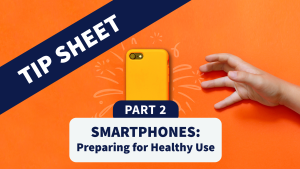
You’ve done your homework, assessing your child’s signs of readiness and your unique family’s needs. Now, you’ve decided: it’s time for your child to have their own smartphone. What are the best ways to incorporate this powerful tool into daily life that promote child health, well-being and safety? How can rules be set with a minimum of conflict or disruption?
Children and Screens convened a panel of media experts, child safety advocates, parenting coaches, and communications researchers to answer the essential questions for parents and caregivers around smartphone introduction and preparing families for healthy use of these powerful devices. (Keep your eye out for other tip sheets in this series: Smartphones: Assessing Readiness, and After the Smartphone: What Now?)
Before possession – prepare children for healthy use
Conversations about family expectations for healthy and safe smartphone use need to happen before the child takes possession of the phone, says Devorah Heitner, PhD, author of Growing Up in Public: Coming of Age in a Digital World.
These conversations should start early and take place often and may cover a range of topics depending on your family’s expectations and values around device management.
Observe your child and talk through potential trouble spots
Heitner suggests noting and addressing trouble spots in the child’s use of other digital media first. “Observing where your child has been successful in their communication with others using a digital tool versus where they have struggled or needed support is going to be really helpful as you prepare them to launch into a phone,” says Heitner. “We need to start having these conversations with our kids about the ways we hope that they will behave and the choices we want to reinforce and support before they even get a phone.”
Some examples of behavior to observe include use of school-administered devices, video games and tablets, and even interactions with parents’ or older siblings’ smartphones.
Prepare them for difficult content
Disturbing or inappropriate content is difficult to avoid – not only when a child gets their own smartphone but in peer groups that also have smartphones. Having conversations to prepare your child for how they may feel when they see this content can be helpful. “It’s the same way that we prepare our children to go to a park. You can have those same conversations about ‘What do you do if you see something that makes your stomach feel icky?’ – you don’t have to say these words like ‘pornography’ or other things that are horrific to really scare your children, but you can let them know if it’s something uncomfortable, what can they do?” says Elizabeth Milovidov, PhD, JD, founder of DigitalParentingCoach.com.
Elizabeth Englander, PhD, director of the Massachusetts Aggression Reduction Center and Professor of Psychology, Bridgewater State University, concurs. “There are devices and networks everywhere. And the idea that you can shield kids from this is probably not always possible. But what we always have are those conversations with kids, not so they know everything, but so they know that you’re willing to talk about it, so they know they can come to you if something weird or icky or scary has happened.”
“I think it’s important to talk with kids also about the shadow areas of the Internet — the categories of content that are adjacent to dangerous categories,” says Heitner.” With the pornography question, I think it’s also important to buy yourself some time. One technique I would suggest to parents is saying, ‘I’m so glad you asked’ while you’re collecting your panic about answering the question, because you really are glad that they asked because if they didn’t ask you, they’re going to ask Alexa or Siri or Google, and once they Google that, they’re going down to the rabbit hole to see some things they can never unsee.”
Teach texting and phoning skills first
“I would strongly suggest focusing on texting as the first real skill set with a phone and also even making and receiving phone calls,” says Heitner. “Texting is such an important way for kids to connect with classmates, friends, peers, even their teams.”
However, teaching children the limits of texting and when it might be better to address a topic with a voice conversation is a vanishing skill that would be helpful for children to learn for social and relationship development. “One of the things that happens as parents is we are literally thumbing out our lives in front of our kids. And they’re not hearing us on the phone the way we heard our parents on the phone,” says Heitner. “So we’re missing that opportunity to talk to them about how [to delineate between texting and talking situations] unless we actually make it explicit, unless we’re on the phone and we say, ‘You know, I’m going to actually tell grandma this big news instead of texting her because this is such big news and we want to kind of be with her while she responds.’ Or ‘I’m having a conflict right now. We’re not really understanding each other. So, I’m going to call the person to try to work it out because it’s just getting worse with texting.’”
Limited access is OK
Consider ways to introduce the smartphone that limits access to the most addicting apps and content, suggests Heitner. “Maybe you’re not ready to let your kid have TikTok, but if there’s a few memes that they feel like they must see for water cooler conversation. Would you be willing to download the app and look at those memes with them a couple of times a week on your phone if you’re not ready for them to independently explore that app?” she says. “I don’t think we have to think about smartphone versus no smartphone as completely black and white – I don’t have to give my kid 24/7 access to their best smartphone that they’re going to have all the time. I think that’s a huge help for parents thinking about ‘How can I gradually let my kid get used to this and learn how to do it successfully?’”
Talk about the realities of group text social conflict
Group chats have become popular among tweens and adolescents, and sometimes these chats are as large as a whole class or grade. Preparing children for uncomfortable situations that might ensue can help them develop the tools to behave in less reactionary ways. “One of the things we want to do, ideally before a kid is getting into this, is start asking them theoretical questions, like ‘What would you do if everyone said let’s restart the soccer group text, but without Sean?’ Or, ‘What would you do if people start talking in a mean way about a teacher?’ And not that there’s a right or wrong answer, but just , ‘Let’s brainstorm. Think of some options,” says Heitner.
Rule-setting tips
Set expectations for behavior BEFORE getting the phone
Boundaries around smartphone use should be set before the smartphone comes into the child’s possession – and ideally, are well-communicated long before as part of an overall family media plan and rules. “As kids get older, ideally you want to be in a position as a parent where you’ve set up the rules long before and they’re so accustomed to them that you’re going to get less pushback,” says Englander.
Frame rules for health rather than safety
Kids are more receptive to smartphone rules and boundaries they can understand from a health perspective instead of a perceived parental overconcern with safety, says Englander. “Sometimes posing things not so much as ‘What rules will keep you safe?’ but also ‘What rules will keep you healthy?’” can be more effective. “Anything where you’re emphasizing to them that, ‘Yes, we’re all going to have to live with technology, but we also have to have a life and we have to be healthy and that means we have to have relationships and mental health and we have to talk with each other and all these other things,’” she says.
Work WITH your kids to maximize buy-in
“Don’t forget to involve the kids in the rule setting itself,” says Stephen Balkam, founder and CEO of Family Online Safety Institute. “In my family’s online safety contract, the most important part of that contract is the blank space, the blank lines that we leave for parents and kids themselves to come up with ideas and rules. We even found that by saying, ‘Okay, if you break that rule, what do you think should be the punishment?’ Sometimes our daughter’s answer was even more severe than our own.” Balkam also suggests that if there is an older sibling, the sibling can be helpful support in setting appropriate rules as well.
Get all parents and caregivers on the same page
Sometimes parents and caregivers are split among different houses, or even parents that share a roof may be on a different page around rules for smartphone use. This can create difficult situations for children and adults alike to navigate.
Englander shares that in difficult conversations with a co-parent on setting rules for smartphone use, “I sometimes find that parents are more likely to share goals than they are to want to share specific rules.” In order to arrive at a parenting solution that works for all, she suggests to “focus on goals first before you focus on rules, because you can easily come up with very different rules. If your goal is to avoid certain situations or to make sure the kids aren’t gaming with strangers, whatever your goal is, if you start with that, it may be easier to come to a place where you have even slightly different rules, but you agree that that’s the goal of the rules.”
“It really gets down to communication between the various adults involved.” says Balkam. “Kids latch on pretty quickly that there are different rules at Dad’s house or Mom’s house or whatever.” Meryl Alper, PhD, Associate Professor of Communication Studies, Northeastern University, suggests that any mediated agreements between parents that have split should include technology, “but even in one household, the parents may need to get on the same page. You definitely don’t want to surprise the other parent with a new gaming device or phone.”





